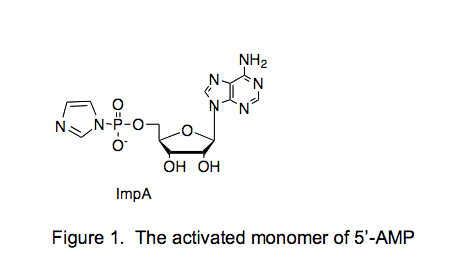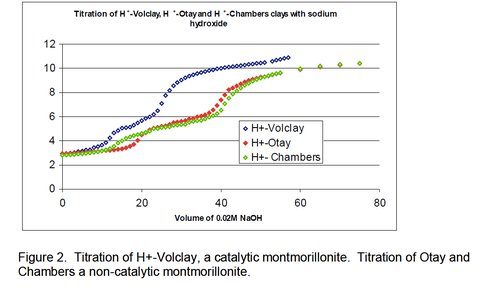2009 Annual Science Report
 Rensselaer Polytechnic Institute
Reporting | JUL 2008 – AUG 2009
Rensselaer Polytechnic Institute
Reporting | JUL 2008 – AUG 2009
Project 7: Prebiotic Chemical Catalysis on Early Earth and Mars
Project Summary
The “RNA World” hypothesis is the current paradigm for the origins of terrestrial life. This hypothesis proposes that the first life on Earth was based on RNA, and that RNA subsequently catalyzed life based on DNA. Our research is aimed at testing a key component of the paradigm, i.e., the efficiency with which RNA molecules form and grow under realistic conditions. We are investigating abiotic production and polymerization of RNA by catalysis on montmorillonite clays. We find that RNA chains some 50 units long can be formed in the laboratory from activated RNA monomers with montmorillonite as a catalyst, and that 12 of the 22 montmorillonites we tested are catalytic. A correlation is found between catalytic activity and charge: montmorillonites with a low negative charge are catalytic, those with a high negative charge are not.
Project Progress
The montmorillonite clay-catalyzed reactions of activated nucleotides generate oligomers as long as 50-mers (Ferris et al., 1996; Huang & Ferris, 2003; Huang & Ferris, 2006).

Figure 1. The activated monomer of 5’-AMP.
The extent of catalysis depends on the magnitude of the negative charge on the montmorillonite lattice and the number of cations associated with it. When cations in raw montmorillonites are replaced by sodium ions, the resulting Na+-montmorillonite does not catalyze oligomer formation because they saturate the interlayers between the platelets of montmorillonites, which blocks the binding of the activated monomers. Treating the montmorillonite with dilute hydrochloric acid replaces the cations on the raw montmorillonite with protons (Joshi et al., 2009). The protonated montmorillonite, titrated to pH 6-7, serves as a catalyst for the formation of RNA oligomers.
Figure 2. Titration of H+-Volclay, a catalytic montmorillonite. Titration of Otay and Chambers a.
The titration does not add sufficient sodium ions to the interlayers of the montmorillonite platelets to prevent the activated monomer from entering. It was noted that non-catalytic montmorillonites have a higher negative charge on their platelets that is due mainly to the natural substitution of the tetravalent and trivalent elements in the montmorillonite lattice with trivalent and divalent metal ions, respectively. The larger negative charge on these montmorillonites was demonstrated by the almost two fold greater amounts of sodium hydroxide needed to titrate non-catalytic montmorillonites as compared to the catalytic montmorillonites (Joshi et al., 2009). Adsorption isotherms established that the equilibrium binding is strongest for ImpA and weakest for ImpU. Of the twenty-two montmorillonites investigated, twelve were catalysts. This research provides insight into the mechanism of the catalytic process.
The catalytically active montmorillonites are all of Cretaceous age (~100 My). Could chemically similar montmorillonites have also been present on the early Earth (e.g., Hadean)? If so, volcanic eruptives and aqueous environments would have needed to be similar in the Hadean to those that produced the Cretaceous-age montmorillonites. To address the issue of volcanic eruptives, the primary igneous minerals preserved within the Cretaceous montmorillonites (i.e., bentonites) are being chemically analyzed for comparison with the mineralogy of mineral inclusions within Hadean zircons (e.g., Hopkins et al., 2008; Mass et al., 1992; Trail et al., 2004). To constrain the environments, the open system element fluxes that led to the specific compositions of Cretaceous montmorillonites are being constrained by determining the original (i.e., glass) composition of the volcanic eruptive. The inferred element fluxes will constrain the depositional environments and diagenetic processes that led to these montmorillonites.
Detection of the RNA polymerization products using Matrix-Assisted Laser Desorption-Ionization-Mass Spectrometry (MALDI-MS) is under investigation. Adenosine-5’-monophosphate polymerizes easily and is readily detected; up to 40-mers were observed in MALDI-TOF. Guanosine-5”-monophosphate is significantly more difficult to polymerize because it can form secondary structures in the presence of metal cations that also hinder the addition of an imidazole ring that facilitates polymerization. Removal of sodium chloride allowed polymerization to proceed and MALDI-TOF detected oligonucleotides up to 25-mers. Interestingly, we found that detectability was greatly improved when the RNA was desorbed from fused silica plates instead of traditional metal MALDI probe surfaces. This is an unexpected and important result that warrants further investigation.
-
PROJECT INVESTIGATORS:
-
PROJECT MEMBERS:
Michael Aldersley
Research Staff
Prakash Joshi
Research Staff
Lauren Cassidy
Graduate Student
Alex Meola
Undergraduate Student
Joseph Thompson
Undergraduate Student
-
RELATED OBJECTIVES:
Objective 3.1
Sources of prebiotic materials and catalysts
Objective 3.2
Origins and evolution of functional biomolecules

